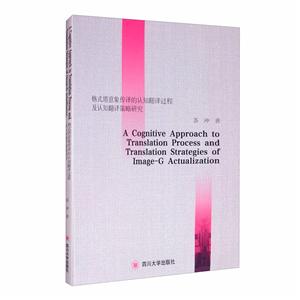-
>
心理学经典文丛:女性心理学
-
>
贫困一代:被社会囚禁的年轻人
-
>
乌合之众:大众心理研究(英汉双语修订版)(套装共2册)
-
>
始于极限:女性主义往复书简
-
>
融合文化(新媒体和旧媒体的冲突地带)/文化和传播译丛
-
>
看不见的女性
-
>
县乡中国:县域治理现代化
格式塔意象传译的认知翻译过程及认知翻译策略研究 版权信息
- ISBN:9787569038385
- 条形码:9787569038385 ; 978-7-5690-3838-5
- 装帧:一般胶版纸
- 册数:暂无
- 重量:暂无
- 所属分类:>
格式塔意象传译的认知翻译过程及认知翻译策略研究 内容简介
作为认知翻译的重要研究内容,格式塔意象的传译已经引起了学界的关注。本书拟从认知翻译学的角度出发,结合认知语言学、认知心理学的相关概念与理论,主要采用质性研究方法,以中国古典诗词为例,探讨格式塔意象识解、建构的认知翻译过程及认知翻译策略问题。具体关注以下问题:(1)在格式塔传译中,译者如何识解源文本中的格式塔意象?(2)在格式塔传译中,译者如何根据源文本中格式塔意象的识解在目标文本中对之进行构建?
格式塔意象传译的认知翻译过程及认知翻译策略研究 目录
1.1 Research background
1.2 Research questions and significance
1.3 Research methodology
1.4 Layout of the study
Chapter Two Literature Review
2.1 Images in classic Chinese poetry11
2.2 Image-G in classic Chinese poetry
2.3 Research on image translation 15
2.4 Research on image-G actualization29
2.5 Summary
Chapter Three Theoretical Framework
3.1 Introduction
3.2 Embodiment and experiential basis of image-G
3.3 Construal of image-G
3.4 Image-G construal mode
3.5 Theoretical framework of the present study
Chapter Four Translators'Construal of Image-G in Source Text
4.1 Introduction
4.2 Aesthetic embodied basis for translators' construal of image-G
4.3 Gestalt characteristics of translators'recognition of image-G
4.4 Cognitive dimensions of translators'construal of image-G
4.5 Representation of image-G in literary discourse space
4.6 Summary
Chapter Five Translators'Construction of Image-G in Target Text
5.1 Introduction
5.2 Complete correspondence
5.3 Inclusive correspondence
5.4 Crossed correspondence
5.5 Disrelation
5.6 Summary
Chapter Six Cognitive Translation Strategies of Image-G Actualization
6.1 Introduction
6.2 Im age-G preservation strategy
6.3 Image-G reinforcement strategy
6.4 Image-G restructuring strategy
6.5 Image-G accretion strategy
6.6 Image-G modulation strategy
6.7 Summary
Chapter Seven Appraisal of Cognitive Translation Strategies:A Contrastive Analysis of Three Translated Versions of “Jiangxue”
7.1 Introduction
7.2 Images and image-G in“Jiangue”
7.3 Cognitive translation strategies adopled in three translated versions
7.4 Summary
Chapter Eight Conclusion
8.1 Research findings
8.2 Research limitations and research pospts
References
后记
格式塔意象传译的认知翻译过程及认知翻译策略研究 节选
Structuralistic linguistics believes that language is a true-to-life reflection of the objective world.However,the research on the subjectivity of human beings as cognitive subjects has not been deeply conducted yet in its research field(Newman,2001).With the revival of humanism,increasing attention has been paid to human beings as cognitive subjects.Cognitive linguistics holds that language is not just a mirror image of the objective world.It is impossible for human beings to understand the objective world without the involvement and effect of their subjective factors,namely,a"reality-cognition-language"process.In other words,the conceptualization of the objective world itself is construed by human being's subjective cognitive processing.Thus construal theory was proposed by Langacker (1987).He defined construal as a cognitive ability that human being choose different perspectives on the same scene in different scope with different salient point in order to achieve the comprehension of certain scene.This process is to some extent potentially of highly subjective.Conceptualization and categorization,as two important notions in cognitive linguistic,provide a cognitive basis and explanations for construal of image-G which will be illustrated as following. One fundamental viewpoint of cognitive linguistics is that human have no access to a reality independent of human conceptual structure.A feature of linguistic scene is a general commitment to cognitive realism,in other words,to the study that language is a conceptual or cognitive phenomenon.To be sure,on the premise of that language is a conceptual phenomenon,the every phase of language usage will be simplified in presentation or analysis,ultimately,to matters of mental processing.In particular,meaning will be constructed in terms of mental processing.As a matter of fact,Langacker(1996)equated the construal of linguistic items with conceptualization.Conceptualization is almost regarded as identical to cognitive processing and mental experience in the sense that it requires,which is closely related with human mental experience.Thus linguistic meanings are a function of both the conceptual content evoked in human mind and the construal imposed on that content.Meaning construction provides evidence that encyclopedic knowledge of human being's conceptual system is reflected in construal process,including inferencing strategies concerning various aspects of conceptual system,framework and system.The dynamic characteristics of meaning construction have been most profoundly analyzed by Fauconnier (2005).He demonstrated the functional flow of dynamic construction which involves conceptual interrelatedness between individual mental spaces and conceptual groupings of information.It is accumulated throughout the conceptual process of semantic construction.In sum,perception and conceptioncan be considered as parallel. Thus,it could be concluded that image-G is not objectively given,but subjectively constructed.Even for expressions pertaining to object reality in literary works,they are realized by describing the cognitive routines that constitute a translator's construal of it.The subject matter of semantic analysis of image-G is human conceptualization.The structures of concern are those that translators impose on their mental experience through active cognitive processing.According to this view,semantic meaning of image-G is actually construed at the conceptual level: Meaning construction of image-G is equated with human beings' conceptualization and construal,a dynamic process whereby linguistic units serve as a prompts for a cue of conceptual functioning and the gathering of semantic information in literary discourse. It is in agreement with the opinion that the construal of image-G is a process instead of a separated concept that can be assembled by language. ……
格式塔意象传译的认知翻译过程及认知翻译策略研究 作者简介
苏冲,女,1988年1月生,四川南充人。西南石油大学外国语学院教师,英语语言文学博士,研究方向为认知翻译研究、认知语言学。
- >
随园食单
随园食单
¥20.6¥48.0 - >
小考拉的故事-套装共3册
小考拉的故事-套装共3册
¥36.7¥68.0 - >
人文阅读与收藏·良友文学丛书:一天的工作
人文阅读与收藏·良友文学丛书:一天的工作
¥18.3¥45.8 - >
我从未如此眷恋人间
我从未如此眷恋人间
¥16.4¥49.8 - >
企鹅口袋书系列·伟大的思想20:论自然选择(英汉双语)
企鹅口袋书系列·伟大的思想20:论自然选择(英汉双语)
¥6.3¥14.0 - >
自卑与超越
自卑与超越
¥13.5¥39.8 - >
有舍有得是人生
有舍有得是人生
¥31.5¥45.0 - >
月亮虎
月亮虎
¥17.8¥48.0
-
汉字有话说-说出中华文化原初样式
¥24.4¥58 -
中华经典指掌文库王昌龄诗集/中华经典指掌文库
¥15¥16 -
汉字王国
¥23.5¥46 -
真的不用读完一本书
¥11.2¥35 -
小书馆:古汉语入门
¥26.9¥39 -
语病百讲
¥9.9¥29
















